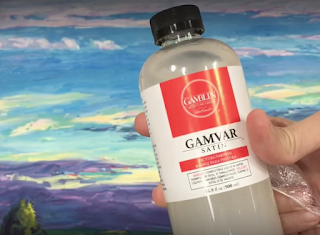–RECENTLY I was preparing a set of paintings to send to my new gallery, the Leopold Gallery in Kansas City. To hit a tight exhibition deadline I needed to use a fast drying paint. I opted to use Gamblin's Fastmatte colors. I was very pleased with the results–all my paintings were dry in time to ship on schedule. However, as you might imagine from the name Fastmatte the colors dry with a noticeably more matte finish than their regular counterparts.
Fortunately, in addition to the Fastmatte paint I also ordered a set of Gamblin varnishes, which come in three variations: gloss, satin, and matte. Since I previously had a less than ideal experience with another brand of gloss varnish (which was excessively glossy) I opted to test the satin finish in the Gamblin brand. I was pleased that the formula went on smooth and flat with a minimum of bubbles. None of the bubbles persisted into the dried layer. See my video below to see how the satin varnish improved depth of color and value.
Additionally, there was little or no odor, which was a major plus. And my test painting was dry the next day and ready to ship which I found remarkable (note that I live in an extremely dry climate. Your experience might vary, so be sure to test drying time). Another Gamvar attribute is how it conforms to the topography of paint strokes without pooling.
I haven't tried removing the dried varnish, but the directions here say to use Gamsol and wipe off the dried Gamvar with a lint-free cloth. Another suggestion on the same page says it might be a good idea to oil out the canvas with a mixture of Gamsol and Galkyd medium before varnishing. I imagine this would give a more glossy surface but the excess gloss would be minimized with the next coat of satin Gamvar. This is the technique I will follow next time when I've planned better and have more time before shipping.
Varnishing has always been an extremely trying experience for me in the past, but it looks like Gamblin has taken away the frustration. Many thanks.
Brad Teare –October 2017
Fortunately, in addition to the Fastmatte paint I also ordered a set of Gamblin varnishes, which come in three variations: gloss, satin, and matte. Since I previously had a less than ideal experience with another brand of gloss varnish (which was excessively glossy) I opted to test the satin finish in the Gamblin brand. I was pleased that the formula went on smooth and flat with a minimum of bubbles. None of the bubbles persisted into the dried layer. See my video below to see how the satin varnish improved depth of color and value.
Additionally, there was little or no odor, which was a major plus. And my test painting was dry the next day and ready to ship which I found remarkable (note that I live in an extremely dry climate. Your experience might vary, so be sure to test drying time). Another Gamvar attribute is how it conforms to the topography of paint strokes without pooling.
I haven't tried removing the dried varnish, but the directions here say to use Gamsol and wipe off the dried Gamvar with a lint-free cloth. Another suggestion on the same page says it might be a good idea to oil out the canvas with a mixture of Gamsol and Galkyd medium before varnishing. I imagine this would give a more glossy surface but the excess gloss would be minimized with the next coat of satin Gamvar. This is the technique I will follow next time when I've planned better and have more time before shipping.
Varnishing has always been an extremely trying experience for me in the past, but it looks like Gamblin has taken away the frustration. Many thanks.
Brad Teare –October 2017


(Sorry about that deleted comment; couldn't edit so I am re-doing) Okay, so I am wondering if that jeweled effect (at 44 seconds in the video) is ever possible by adding texture to acrylic paint and then applying a gloss medium over the top. I paint with acrylics, but am wondering about switching over to oils (even more so now that I've seen your beautiful painting).
ReplyDeleteThis varnish works with acrylics as well as oils. If you want to add a gloss like you mentioned I would use the gloss varnish straight. You can mix it with the satin or matte varnishes to get intermediate glossiness or matte finishes. It works great over acrylic and you can remove it if you don't like the finish. Good luck. Let me know how it goes.
DeleteThank you! Glad to know I can use this with acrylics too. I have Liquitex Gloss Medium and Varnish so thinking of trying that in the near future. I am getting rather confused with all the recommendations out there though. Probably experimenting will help some. Thanks again.
DeleteYou can mix them together to get variations in glossiness (or non-glossiness).
DeleteHelpful post. I am happy to know about the use of varnish.
ReplyDeleteThanks Brad!!
Glad you liked the post, Brian. In the past I found vanishing extremely frustrating. It’s good to simplify the process.
DeletePrint Plotter A0
ReplyDeletePrint Plotter A1